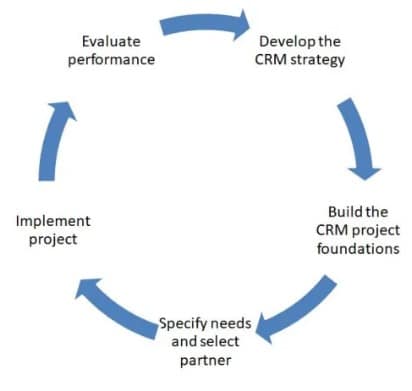Is Your CRM Strategy Failing? Here’s What You Need to Do – In today’s highly competitive business environment, companies need to have a robust CRM strategy to stay ahead of their competition. However, despite investing in expensive CRM systems, many companies fail to achieve the desired results.
This article will explore some of the common reasons why CRM strategies fail and provide actionable solutions to help you improve your CRM strategy.

Introduction
CRM, or customer relationship management, is the process of managing interactions with current and potential customers. It is an essential tool for businesses looking to streamline their sales, marketing, and customer service efforts. However, despite its importance, many companies struggle to implement an effective CRM strategy.
What is CRM and Why is it Important?
CRM refers to the strategies, technologies, and practices that companies use to manage and analyze customer interactions and data throughout the customer lifecycle. The goal of CRM is to improve customer satisfaction, increase customer loyalty, and ultimately drive sales growth.
An effective CRM strategy helps businesses to better understand their customers’ needs, preferences, and behaviors. It enables companies to personalize their interactions with customers and deliver more relevant and targeted marketing campaigns. It also helps businesses to identify cross-selling and upselling opportunities, leading to increased revenue and profitability.
Common Reasons for CRM Failure
Despite its many benefits, many companies struggle to implement an effective CRM strategy. Here are some common reasons why CRM strategies fail:
Lack of Clear Goals
One of the most common reasons why CRM strategies fail is a lack of clear goals and objectives. Without clear goals, companies may struggle to measure the success of their CRM initiatives and may not allocate the necessary resources to support them.
Poor Data Quality
CRM relies heavily on accurate and up-to-date data. If the data in your CRM system is incomplete, outdated, or inaccurate, it can lead to poor decision-making and customer dissatisfaction.
Inadequate Training
Another common reason for CRM failure is inadequate training. If employees are not properly trained on how to use the CRM system, they may not be able to take full advantage of its features and functionalities.
Lack of User Adoption
Even if a company invests in a state-of-the-art CRM system, it won’t be effective if employees don’t use it. Poor user adoption can be caused by a lack of training, a lack of support, or a resistance to change.
Insufficient Integration
Finally, many CRM strategies fail because of insufficient integration with other business systems. If your CRM system doesn’t integrate with your sales, marketing, and customer service tools, it can lead to inefficiencies and missed opportunities.
Actionable Solutions for Improving CRM Strategy
To improve your CRM strategy, consider implementing the following solutions:
Define Clear Goals and Objectives
Define clear and measurable goals and objectives for your CRM initiatives. This will help you to track progress and allocate resources effectively.
Ensure Data Quality
Regularly review and update your customer data to ensure that it is accurate and up-to-date. Consider investing in data cleansing tools to automate this process.
Provide Adequate Training
Provide employees with adequate training on how to use the CRM system. This will ensure that they understand the system’s features and how to use them effectively. Consider offering ongoing training to keep employees up-to-date on any system changes or updates.
Encourage User Adoption
To encourage user adoption, make sure that employees understand the benefits of using the CRM system. Provide ongoing support and feedback to help them feel comfortable and confident in using the system.
Implement Seamless Integration
Integrate your CRM system with your other business systems, such as your sales, marketing, and customer service tools. This will ensure that data is shared seamlessly across systems, leading to greater efficiency and better customer experiences.
Conclusion
In conclusion, a well-executed CRM strategy can provide many benefits to a company, including increased revenue, improved customer satisfaction, and enhanced internal collaboration. However, if your CRM strategy is failing, there are actionable solutions to help you turn things around.
By defining clear objectives, improving data quality, providing adequate training and adoption support, ensuring sufficient integration, allowing for flexibility, and measuring and analyzing success, you can build a successful and effective CRM program.
FAQs
- What are the benefits of using a CRM system? A: CRM systems help businesses to better understand their customers’ needs, preferences, and behaviors. They enable companies to personalize their interactions with customers and deliver more relevant and targeted marketing campaigns. They also help businesses to identify cross-selling and upselling opportunities, leading to increased revenue and profitability.
- How can I improve the data quality in my CRM system? A: Regularly review and update your customer data to ensure that it is accurate and up-to-date. Consider investing in data cleansing tools to automate this process.
- Why is user adoption important for CRM success? A: Even if a company invests in a state-of-the-art CRM system, it won’t be effective if employees don’t use it. Poor user adoption can be caused by a lack of training, a lack of support, or a resistance to change.
- How can I encourage user adoption of my CRM system? A: To encourage user adoption, make sure that employees understand the benefits of using the CRM system. Provide ongoing support and feedback to help them feel comfortable and confident in using the system.
- What is the role of integration in a CRM strategy? A: Integration is essential for an effective CRM strategy. Integrating your CRM system with your other business systems, such as your sales, marketing, and customer service tools, ensures that data is shared seamlessly across systems, leading to greater efficiency and better customer experiences.